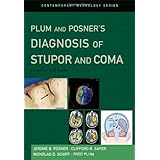
Average Reviews:

(More customer reviews)Plum and Posner is a classic book to be read by every doctor atleast once in his/her lifetime. I was fortunate to use the third edition of this book during my postgraduate days and later in practice. Now the fourth edition is even greater to read, expanded, uptodate and remains very clinical as the previous edition. It will be a very valuable addition to those who care for acute neurological patients. There is no other book like this and it will be a classic forever. The neurological community will always remain thankful to the authors for bringing out this new edition.
The publishers have failed us miserably for the fragile binding used. The pages keep coming away as you read the book. It is very unfortunate that they have made this kind of compromise. They should have known that this book is meant for the trenches and not for the coffee table.
Click Here to see more reviews about: Plum and Posner's Diagnosis of Stupor and Coma (Contemporary Neurology71)
Delirium, stupor and coma are common clinical states that confront clinicians in almost every medical specialty.With appropriate diagnosis and treatment, coma can often be treated successfully.Conversely, delay in diagnosis and treatment may be lethal. This monograph provides an update on the clinical approach that was laid out in the previous 3 editions.It describes an approach for the physician at the bedside to diagnose and treat alterations of consciousness, based on pathophysiologic principles.The book begins with a description of the physiology of consciousness and the pathophysiology of disorders of consciousness.It continues with a description of the approach to a patient with a disorder of consciousness, emphasizing the bedside examination, but including the use of modern imaging techniques.The important structural and metabolic causes of coma are reviewed in detail.It then describes the emergency treatment, both medical and surgical, of patients with specific disorders of consciousness and their prognosis. New chapters describe the approach to the diagnosis of brain death and the clinical physiology of the vegetative state and minimally conscious state, as well as the ethics of dealing with such patients and their families.The book is aimed at medical students and residents, in fields from internal medicine and pediatrics to emergency medicine, surgery, neurology, neurosurgery, and psychiatry, who are likely to encounter patients with disordered states of consciousness.It includes historical background and basic neurophysiology that is important for those in the clinical neurosciences, but also lays out a practical approach to the comatose patient that is an important part of the repertoire of all clinicians who provide emergency care for patients with disorders of consciousness.

0 comments:
Post a Comment